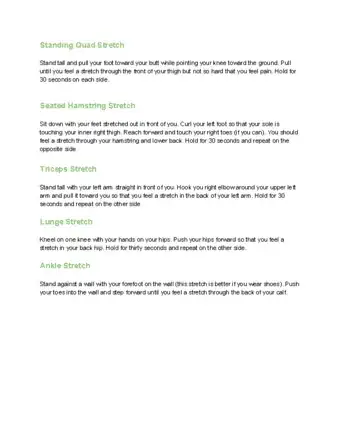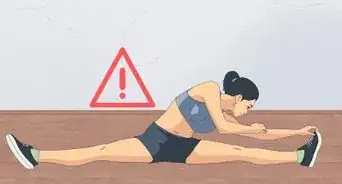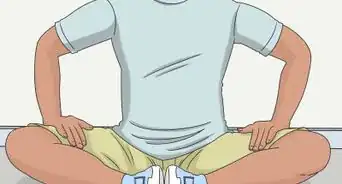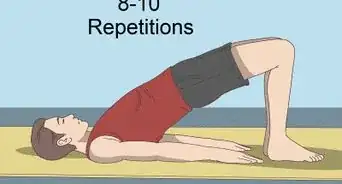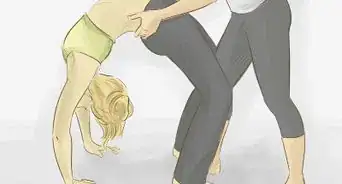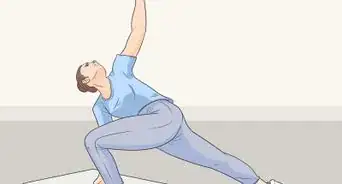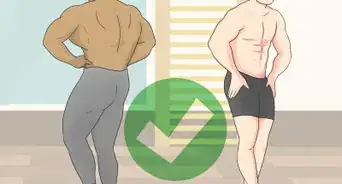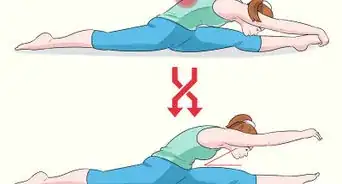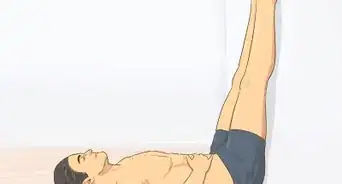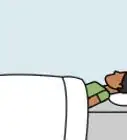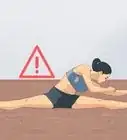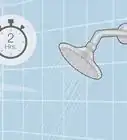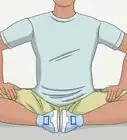This article was co-authored by Eric Christensen, DPT. Eric Christensen is a Physical Therapist based in Chandler, Arizona. With over a decade of experience, Eric works in both orthopedic and neurological fields and specializes in custom orthotic prescription and casting, vestibular reprogramming, and manual therapy. He holds a Bachelor’s degree in Exercise Science with a focus in Sports Medicine from Colorado State University and a Doctor of Physical Therapy from Regis University. In practice, Eric takes a developmental approach to rehabilitation utilizing the Selective Functional Movement Assessment. He uses functional movement patterning and manual therapy to return patients to prior levels of function.
There are 9 references cited in this article, which can be found at the bottom of the page.
wikiHow marks an article as reader-approved once it receives enough positive feedback. This article has 34 testimonials from our readers, earning it our reader-approved status.
This article has been viewed 212,318 times.
If you have dreams of becoming a successful gymnast, dancer, or athlete, you will need to be as strong and as flexible as possible. Before you start stretching, there are a few terms you need to know. Static stretching is when you hold a stretch in a challenging, but still comfortable position. Dynamic stretching involves repeatedly moving through the same range of motion and active stretching is when you contract a muscle in opposition to the muscle you’re currently stretching. Now that you know the terms, it’s time to warm up.
Steps
Learning Basic Stretches
-
1Do a straddle stretch. Sit on your bottom on the ground. Stretch your legs long and open them up as wide as they will go. Point your feet and place your hands on the ground in front of you to balance yourself. You should feel this stretch in your hips and your inner thighs.[1]
- Stay in this stretch for fifteen seconds.
- Try to open your legs wider each time you do this stretch. The goal is to eventually be able to do a split.
- When doing any stretch, focus on consistency instead of pushing your body to its limit.[2]
-
2Practice a pike stretch. Sit on your bottom with your legs extended in front of you and your arms lifted straight overhead. Fold at your waist and reach your arms towards your toes.[3]
- Stay in this stretch for fifteen seconds.
- You may not be able to reach your toes right away. Keep trying and as you get more flexible, you’ll get closer and closer to touching them.
Advertisement -
3Try a lunge stretch. Stand with your left leg in front of you and your right leg behind you. Bend your left leg at a 90-degree angle, and rest your right leg on the ground to support yourself. Rest your hands on your left leg and use them to push your left leg even deeper into the stretch.[4]
- Stay in your left lunge for 15 seconds.
- After 15 seconds, switch and do the same thing on your right side.
-
4Do cross-body arm stretches. Stand with your feet apart (they should be slightly wider than your shoulders). Reach your right arm across your body, and use your left arm to support it and lock it into place.[5]
- Pull your arm tight until you feel a stretch in your shoulder.
- Hold your arm stretch for ten seconds, before alternating and doing the same stretch on the left side.
-
5Stretch your arms behind your back. Standing straight, cross your right arm behind your back. Reach back with your left hand and grab your right hand. Use the left hand to stretch the right arm. Hold the stretch for about 15 seconds. Repeat. This time, use your right hand to grab and pull your left hand.
- As you do this, try stretching your neck. Bend your head towards the same side as the arm that is grabbing and pulling. If you are grabbing with your left hand, tip your head to the left side.
-
6Do side bends. Stand with your feet apart (they should be slightly wider than your hips) and your arms outstretched. Lean over to your right side until your right arm hangs down towards the ground and your left arm reaches straight up over your head.[6]
- Pull your left arm taut until you feel a stretch in your left shoulder and the left side of your body.
- Hold this stretch for ten seconds on the right side, before switching sides and reaching with your right hand. As you bend to the side, dangle your left arm towards the ground and stretch the right arm straight up.
-
7Try the Superman. Lie on the ground on your stomach with your arms stretched out in front of you (your body should be in one straight line). Lift your arms and feet off the ground; your arms should be in line with your ears and your feet should be lifted a little higher than your hips.[7]
- Stay in this stretch for fifteen seconds.
- As you get more flexible, try to lift your feet a little higher.
Using Stretching with Gentle Movement
-
1Start with jumping jacks. Stand straight up with your feet together and your arms by your sides. Jump to separate your feet, while simultaneously lifting your arms overhead. Then jump your feet back together, while simultaneously returning your arms to your sides.
- Do fifteen jumping jacks in a row to get your blood pumping.
- As you get older and stronger, you may want to increase the number of jumping jacks you do.
-
2Do arm circles. Stand with your legs slightly wider than your hips. Lift your arms overhead, then make a circle with your arms going towards your hips, then up over your head.[8]
- Keep your arms straight at all times.
- Do ten arm circles going forward, then reverse and do ten backward arm circles.
-
3Try skipping. Stand on your right foot, with your left foot in the air. Hop on the right foot, then step down on your left foot. Speed this motion up until you are able to skip.
- Once you are confident skipping, skip back and forth for a minute at a time.
- As you get stronger and more flexible, increase the length of time that you spend skipping each day.
-
4Practice squats. Stand with your feet shoulder-width apart and facing forward. Keeping the weight in your heels, slowly bend your knees and lower your body towards the ground as though you were about to sit down in a chair.[9]
- Pause at the ground, then slowly rise back up to your previous position and do the motion again.
- Hold your arms out in front of you for balance.
- Make sure that your knees do not go over your toes. If you can see the top of your shoes, you're doing this move right. If not, your knees are too far forward.
Becoming More Flexible Through Active Stretching
-
1Try quad pulls. Bend your left knee and pull your left leg behind your body, using your left hand to support it. Reach your right arm toward the ceiling, as far as it will go. After your arm is lifted, raise up onto your right toes and balance there.[10]
- When you’ve got a good stretch on your left side, switch and do the same thing on your right side.
- Alternate back and forth. Do ten rounds on each side.
-
2Try downward-facing dog. From a standing position, fold your body over at the waist and allow your hands to touch the floor. Walk your hands forward until your body resembles that of an upside-down letter V.[11]
- Your hands should be shoulder-width apart.
- Your fingers should be spread wide.
- Keep your feet hips-width distance apart.
- Try to touch your heels to the floor.
-
3Stand in tree pose. Stand straight up with your feet together. Lift your right foot and tuck it into the space right above your left knee, with your right knee facing out. Put your palms together in front of your heart.[12]
- Stand in this position for ten seconds, then switch sides.
- When your feet are together, your big toes should be touching, and your heels should be slightly apart.
- Make sure your weight is evenly balanced.
- Don't let your foot rest on your knee, it can damage your joints.
-
4Experiment with bow pose. Lie on your stomach with your arms running beside your body – make sure to keep your palms face up. Bend your knees and grab your ankles with your hands.[13]
- When you breathe in, try to lift your knees and thighs even further away from the floor.
- Stay here for five seconds. Take a break, then try this pose two more times.
Sample Stretches
Expert Q&A
-
QuestionHow do you get flexible fast?
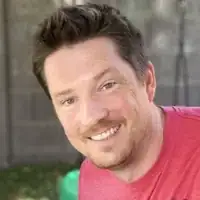 Eric Christensen, DPTEric Christensen is a Physical Therapist based in Chandler, Arizona. With over a decade of experience, Eric works in both orthopedic and neurological fields and specializes in custom orthotic prescription and casting, vestibular reprogramming, and manual therapy. He holds a Bachelor’s degree in Exercise Science with a focus in Sports Medicine from Colorado State University and a Doctor of Physical Therapy from Regis University. In practice, Eric takes a developmental approach to rehabilitation utilizing the Selective Functional Movement Assessment. He uses functional movement patterning and manual therapy to return patients to prior levels of function.
Eric Christensen, DPTEric Christensen is a Physical Therapist based in Chandler, Arizona. With over a decade of experience, Eric works in both orthopedic and neurological fields and specializes in custom orthotic prescription and casting, vestibular reprogramming, and manual therapy. He holds a Bachelor’s degree in Exercise Science with a focus in Sports Medicine from Colorado State University and a Doctor of Physical Therapy from Regis University. In practice, Eric takes a developmental approach to rehabilitation utilizing the Selective Functional Movement Assessment. He uses functional movement patterning and manual therapy to return patients to prior levels of function.
Stretching Coach A lot of people approach stretching with a "more pain, more gain" attitude, but this isn't the best way to go. Becoming flexible is all about consistency, not how much you're working out at once.
A lot of people approach stretching with a "more pain, more gain" attitude, but this isn't the best way to go. Becoming flexible is all about consistency, not how much you're working out at once. -
QuestionHow can I do splits without stretching?
 Michele DolanMichele Dolan is a BCRPA certified Personal Trainer in British Columbia. She has been a personal trainer and fitness instructor since 2002.
Michele DolanMichele Dolan is a BCRPA certified Personal Trainer in British Columbia. She has been a personal trainer and fitness instructor since 2002.
Certified Fitness Trainer Doing splits takes a lot of practice and stretching regularly. Remember to stretch a little at a time and keep at it.
Doing splits takes a lot of practice and stretching regularly. Remember to stretch a little at a time and keep at it. -
QuestionWill I come to the point where I will be as flexible as Simone Biles?
 Michele DolanMichele Dolan is a BCRPA certified Personal Trainer in British Columbia. She has been a personal trainer and fitness instructor since 2002.
Michele DolanMichele Dolan is a BCRPA certified Personal Trainer in British Columbia. She has been a personal trainer and fitness instructor since 2002.
Certified Fitness Trainer Simone is awesome! Every body is different, so listen to your coach and practice to be your best. Who knows how flexible you might become with practice and patience.
Simone is awesome! Every body is different, so listen to your coach and practice to be your best. Who knows how flexible you might become with practice and patience.
Warnings
- If you experience pain when stretching, stop stretching immediately.⧼thumbs_response⧽
References
- ↑ https://www.verywell.com/simple-kids-stretching-exercises-1257070
- ↑ Eric Christensen, DPT. Physical Therapist. Expert Interview. 29 April 2021.
- ↑ http://www.healthykidsrunningseries.org/get-involved/stretching/
- ↑ https://www.verywell.com/simple-kids-stretching-exercises-1257070
- ↑ https://www.verywell.com/simple-kids-stretching-exercises-1257070
- ↑ http://www.nyrr.org/youth-and-schools/running-start/coaching-videos/middle-school/stretches-strength
- ↑ http://www.nationwidechildrens.org/exercises-stretching
- ↑ http://www.n-ltech.com/downloads/articles/Strength_and_Flexibility.pdf
- ↑ http://www.nyrr.org/youth-and-schools/running-start/coaching-videos/middle-school/stretches-strength
- ↑ http://www.nyrr.org/youth-and-schools/running-start/coaching-videos/middle-school/stretches-strength
- ↑ http://www.active.com/health/articles/pose-of-the-month-downward-facing-dog
- ↑ http://www.active.com/parenting-and-family/articles/4-yoga-poses-for-kids?page=2
- ↑ http://www.active.com/parenting-and-family/articles/4-yoga-poses-for-kids?page=2
About This Article
If you want to be strong and flexible, there are a few simple stretches you’ll need to practice regularly. For static stretches, try a straddle position, where you sit with your bottom on the ground, stretch your legs long and open, and walk your hands down as far as you can to stretch your hips and thighs. You can also close your legs into a pike position and reach your arms towards your toes. Alternatively, use dynamic stretches, which are repeated movements, to strengthen your flexibility. For instance, do jumping jacks, arm circles, skipping, and squats. To learn how to use active stretching to become more flexible, keep reading!
-Step-1.webp)
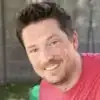
-Step-2.webp)
-Step-3.webp)
-Step-4.webp)
-Step-5.webp)
-Step-6.webp)
-Step-7.webp)
-Step-8.webp)
-Step-9.webp)
-Step-10.webp)
-Step-11.webp)
-Step-12.webp)
-Step-13.webp)
-Step-14.webp)
-Step-15.webp)
